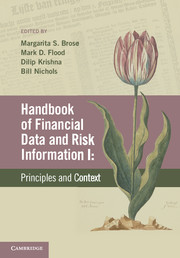Book contents
- Frontmatter
- Contents
- List of contributors
- Preface
- VOLUME I: PRINCIPLES AND CONTEXT
- PART I RISK MANAGEMENT CONTEXT FOR FINANCIAL DATA
- PART II REQUIREMENTS AND SOURCES FOR FINANCIAL RISK MANAGEMENT
- 6 Banking and financial activities in the real economy
- 7 Capital markets data
- 8 Capital markets reference data
- 9 Risk management data and information for improved insight
- PART III REGULATORY DATA
- Index – Volume I
7 - Capital markets data
from PART II - REQUIREMENTS AND SOURCES FOR FINANCIAL RISK MANAGEMENT
- Frontmatter
- Contents
- List of contributors
- Preface
- VOLUME I: PRINCIPLES AND CONTEXT
- PART I RISK MANAGEMENT CONTEXT FOR FINANCIAL DATA
- PART II REQUIREMENTS AND SOURCES FOR FINANCIAL RISK MANAGEMENT
- 6 Banking and financial activities in the real economy
- 7 Capital markets data
- 8 Capital markets reference data
- 9 Risk management data and information for improved insight
- PART III REGULATORY DATA
- Index – Volume I
Summary
Introduction
This chapter gives a high-level overview of capital markets data. We will survey the different types of capital markets data and provide different angles for categorizing them, from the perspective of the instrument or the trade lifecycle. We follow this with a discussion on the data generation process and how that is changing. After this we discuss different metadata aspects – such as quality measures on data, business process context information that specifies the intended usage, as well as information that is typically inferred from capital markets data. We conclude with some observations on developments in capital markets data, how they are sourced and distributed.
Capital markets data comprise generic information about financial products (terms, prices), financial markets participants (issuers, guarantors, trading counter-parties, customers, investors), operational and transactional data (master agreements, settlement instructions) and opinions (equity research, ratings). They also include participant specific information including trades, positions/holdings, port-folios, books, hierarchies, collateral and specific proprietary valuation methodologies, trading strategies and algorithms.
To lend some order to financial products, market practitioners, trade associations (e.g., ISDA), standards organizations (e.g., FpML, ISO, FPL) and infrastructure providers (e.g., SWIFT) have created different classification schemes and descriptive standards. These range from financial product classification and identification standards to complete data models to describe terms and conditions of financial products.
When it comes to categorizing capital markets data, we can for example look at the types of content that play a role in the transaction lifecycle.
- Type
- Chapter
- Information
- Handbook of Financial Data and Risk Information IPrinciples and Context, pp. 271 - 302Publisher: Cambridge University PressPrint publication year: 2014



